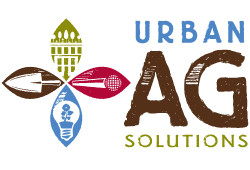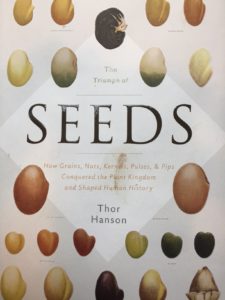Summer’s almost here and that means reading time (if you’re not too busy gardening). Let me suggest to you, if you haven’t already gotten your hands on it, the recently-published, simply-titled Seeds by ecologist Thor Hanson.
I spend a lot of time thinking about and handling seeds, and yet after reading this book I realized I’ve gotten a little too comfortable with my limited view of them as mere objects of the trade. By taking both an ecological (including paleo-ecological) and historical view, Hanson re-gifted me with a sophisticated wonder for these marvelous creations. The book’s division into functional sections is itself a seed lesson: Seeds Nourish, Seeds Unite, Seeds Endure, Seeds Defend, Seeds Travel. Right away, Hanson establishes seeds as active agents of their fate, not mere passive objects. Hanson’s ecological perspective also reframes seeds in two ways. He paints a large picture by being able to put seeds into a web of relationships with physical and biological agents, and he shows that seeds are continuing to evolve, a fact not always apparent to the gardener whose relationship to seeds is limited to objects that come in brightly-colored envelopes. In this book seeds are vibrant, dynamic characters, not some sleepy Rip van Winkles waiting to wake up in some undetermined future.
As a writer, Hanson is smart enough to put the stories up front and the geeky-stuff out back. His narrative line is fresh and forward-moving (one critique: I could have used a little less material about his son, Noah), and the end-notes and the bibliography are full of their own dense, richly-satisfying nourishment. His ongoing personal involvement with the tropical almendro tree and its seeds provides an interesting thread weaving many chapters together, and much of his research is riveting, such as how the seed of the Java cucumber provided the basic shape and aerodynamics for the eerie-looking stealth bomber. Plus he illuminates some of the seed puzzles which I have wondered about but have never had the means/intellect to resolve, such as: If a coconut is a seed, then why the heck is there liquid in the middle? A: (from the Glossary) “Acellular endosperm: An unusual substance found in coconuts, known in the grocery store as ‘coconut water.”‘ It consists of free nuclei floating in a nutritious cytoplasmic bath. As the coconut matures, cell walls form, and much of this material transforms into the meat (i.e., solid endosperm) of the coconut (245).” Thanks, Thor! Now I can check that question off my list.
For entertainment, history lessons, and wonder, Seeds and seeds cannot be beat!

